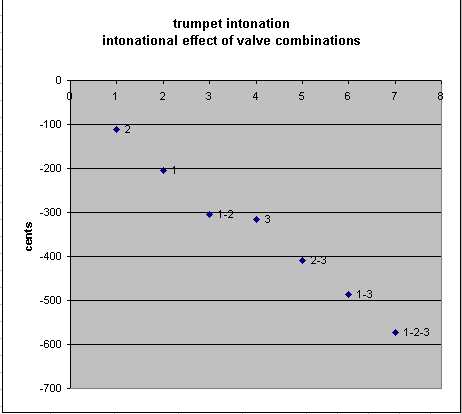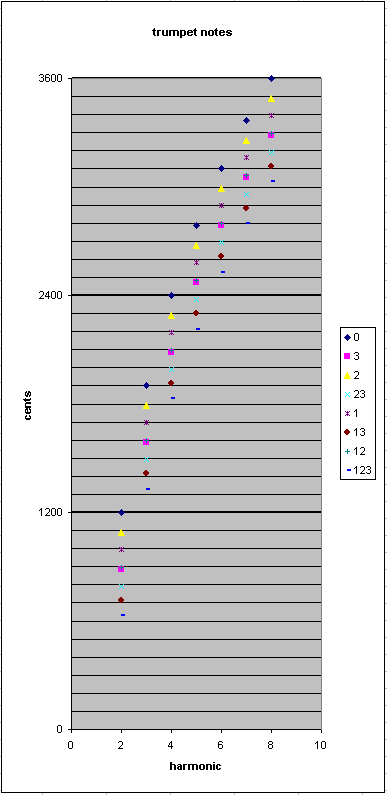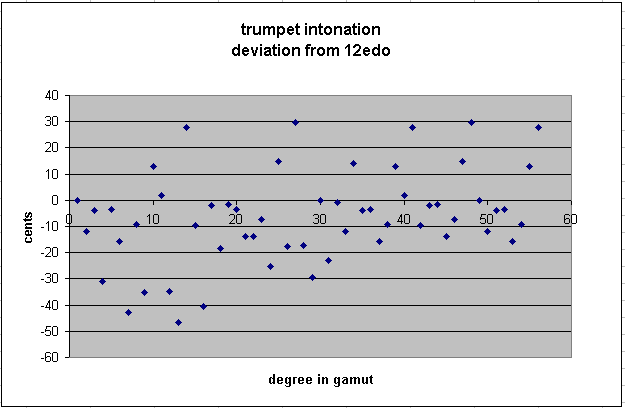i finally
sat down and calculated the theoretical intonation
of the standard valved trumpet.
this is something i've been wanting to know for
years, and just never gave enough thought to it
to figure out exactly how it worked. and i've
never seen anything like this published anywhere
either.
my source (Christopher W. Monk, "The Older Brass
Instruments: Cornett, Trombone, Trumpet", chapter 11
of _Musical Instruments Through The Ages_, ed.
Anthony Baines, 1973 reprint of 1969 3rd edition)
says that the valves lower the pitch of the "natural"
harmonics available on the trumpet, by adding extra
lengths of tubing as follows:
1st valve = 1/8 of the main tube
2nd valve = 1/15 of the main tube
3rd valve = 1/5 of the main tube
this mechanism obviously has a JI basis, so that
the 1st valve lowers the pitch by a 9:8 ratio (-~204 cents = "2 semitones"),
the 2nd by a 16:15 (-~112 cents = "1 semitone"), and
the 3rd by a 6:5 (-~316 cents = "3 semitones").
but as Monk points out (describing it differently,
but it means the same as what i say here), these
ratios only apply when the player uses a *single*
valve. when 2 or 3 are used in combination, the
ratios become much more complex, as follows:
valves ratio ~cents
1 and 2 143:120 -304
1 and 3 53:40 -487
2 and 3 19:15 -409
1, 2, and 3 167:120 -572
here is a tabulation for all valve combinations:
valves ratio monzo ~cents "semitones"
2 3 5 11 13 19 53 167
2 15:16 [-4 1 1 0 0 0 0 0 ] -112 -1
1 8:9 [ 3 -2 0 0 0 0 0 0 ] -204 -2
1-2 120:143 [ 3 1 1 -1 -1 0 0 0 ] -304 -3
3 5:6 [-1 -1 1 0 0 0 0 0 ] -316 -3
2-3 15:19 [ 0 1 1 0 0 -1 0 0 ] -409 -4
1-3 40:53 [ 3 0 1 0 0 0 -1 0 ] -487 -5
1-2-3 120:167 [ 3 1 1 0 0 0 0 -1 ] -572 -6

so i calculated all of the notes which are available
by lowering the 2nd, 3rd, 4th, 5th, 6th, 7th, and 8th
natural harmonics of the trumpet. making "C" the
beginning of each ascending 8ve and designating
"middle-C" as C 4, these are respectively the notes
C 4 , G 4 , C 5 , E 5 , G 5 , Bb< 5 , and C 6 ("high-C").
(i'm using the "less-than" sign as per my 72edo HEWM
notation, to indicate the ~31 cent lowering of the
7th harmonic from the 12edo Bb.)
these are the notes as written for the trumpet.
for the standard Bb trumpet, the actual sounding
pitch will be one "whole-step" lower, and for the
small F trumpet, a "perfect-4th" higher.
one last _caveat_: the way the player uses his lips
has a *tremendous* affect on trumpet intonation.
these cents-values are only theoretical, and may
vary widely. also, i know nothing about variabilities
of tube-length for the valves among different makes
and models of trumpet.
-- played as--- - result -
note harmonic valves 8ve cents
C6 C 6 0 3 0
B5 C 6 2 2 1088
A#/Bb5 C 6 1 2 996
A#/Bb5 Bb< 5 0 2 969
A5 C 6 1-2 2 896
A5 C 6 3 2 884
A5 Bb< 5 2 2 857
G#/Ab5 C 6 2-3 2 791
G#/Ab5 Bb< 5 1 2 765
G5 C 6 1-3 2 713
G5 G 5 0 2 702
G5 Bb< 5 1-2 2 665
G5 Bb< 5 3 2 653
F#/Gb5 C 6 1-2-3 2 628
F#/Gb5 G 5 2 2 590
F#/Gb5 Bb< 5 2-3 2 560
F5 G 5 1 2 498
F5 Bb< 5 1-3 2 482
E5 G 5 1-2 2 398
E5 Bb< 5 1-2-3 2 397
E5 E- 5 0 2 386
E5 G 5 3 2 386
D#/Eb5 G 5 2-3 2 293
D#/Eb5 E- 5 2 2 275
D5 G 5 1-3 2 215
D5 E- 5 1 2 182
C#/Db5 G 5 1-2-3 2 130
C#/Db5 E- 5 1-2 2 83
C#/Db5 E- 5 3 2 71
C5 C 5 0 2 0
C5 E- 5 2-3 1 1177
B4 E- 5 1-3 1 1099
B4 C 5 2 1 1088
A#/Bb4 E- 5 1-2-3 1 1014
A#/Bb4 C 5 1 1 996
A4 C 5 1-2 1 896
A4 C 5 3 1 884
G#/Ab4 C 5 2-3 1 791
G4 C 5 1-3 1 713
G4 G 4 0 1 702
F#/Gb4 C 5 1-2-3 1 628
F#/Gb4 G 4 2 1 590
F4 G 4 1 1 498
E4 G 4 1-2 1 398
E4 G 4 3 1 386
D#/Eb4 G 4 2-3 1 293
D4 G 4 1-3 1 215
C#/Db4 G 4 1-2-3 1 130
C4 C 4 0 1 0
B3 C 4 2 0 1088
A#/Bb3 C 4 1 0 996
A3 C 4 1-2 0 896
A3 C 4 3 0 884
G#/Ab3 C 4 2-3 0 791
G3 C 4 1-3 0 713
F#/Gb3 C 4 1-2-3 0 628

it's very useful to have a table which shows
exactly what the instrument is supposed to produce
under "ideal" conditions. i found it very illuminating,
having thought all this time that trumpets were being
mass-produced these days with a fairly solid version
of 12edo built into them. if Monk's assessment of
the length of tubing for each valve is correct, then
my previous misconception is way off the mark.
in fact, quite a few of the trumpet's pitches are about
10 cents sharp, 30 cents sharp, 20 cents flat, and
40 cents flat in comparision to 12edo.
of course, most of the ones which really deviate far
from 12edo are those that are produced in conjunction
with the lips sounding the 7th harmonic, which i call
Bb<5 . and most players probably don't regularly use
that harmonic as a basis for valved notes; only those
who are microtone-savvy would be interested, the others
hearing them as "out of tune".
and certainly good players could also use the 9th,
11th, and 13th harmonics for microtonal high notes.
i'll include those in my webpage charts. for now,
i figured that the table i posted covers most "typical"
instances of trumpet playing, inclding the microtonalist
who would use the 7th harmonic.

ONE IMPORTANT NOTE:
All modern trumpets have a "tuning slide" on the
tubing connected to the 3rd valve, and also often
on the 1st valve too. By means of adjusting these
slides, which increase the length of tubing associated
with that valve, the player may increase the intonational inflection
of that valve by as much as approximately a
quarter-tone.
I am indebted to George Secor for the following:
Yes, adjustments in lip tension (embouchure) and also the position of
the back part of the tongue (which changes the size of the player's
mouth cavity) may also be used in order to adjust intonation, and the
amount of adjustment possible is greater than with valve slide (or
trigger) adjustments. However, embouchure adjustments also affect
tone quality, and as you would suspect, the greater the adjustment,
the greater the deterioration in quality and the greater the amount
of skill required to control the tone. So if you want microtones,
this technique also has limitations.
Being a brass player (among other things), I've been thinking about
the problem of microtones on valved brass instruments for quite a
long time, and many years ago I came to the conclusion that having
instruments specially built to play in multiple tunings would
ultimately be the best way to go.
A spreadsheet, which I made for Patrick Ozzard-Low, gives a valve
plan for 21st-century (microtonal) valved brass instruments, and it
may be seen here:
http://groups.yahoo.com/group/tuning/files/secor/Brass.xls
A few words of explanation are in order.
1) My plan for valved brass instruments involves only equal divisions
of the octave for the simple reason that the advantages of
temperaments far outweigh the limitations when one considers
instruments of flexible pitch -- and my valve plan accommodates
divisions up to 41-ET, so the distinction of a comma may be made.
2) I have added a fourth valve that is operated by the thumb rather
than the little finger. For 26-ET and up this is to be a 3-position
valve, with the rest position at the center of travel. Bending the
thumb lowers the pitch by 1 system degree, and unbending the thumb
(from the rest position) *raises* the pitch by 1 system degree.
There are several benefits resulting from this arrangement:
a) The thumb has greater strength and independence than the little
finger, making microtonal fingering easier to execute;
b) A 3-position valve offers more valve combinations than a 2-
position valve, so more tones in the octave are possible;
c) For divisions up to 36-ET the first and second-finger valves are
allowed to retain the same function that they have in a conventional
instrument (i.e., lowering by a major and minor 2nd, respectively),
so that many conventional fingerings are retained, resulting in a
much gentler learning curve;
d) For instruments (such as the tuba and piccolo trumpet) that
require enough valve combinations to fill out the range between the
fundamental and 2nd harmonic (i.e., an entire octave), an additional
valve could be operated by the little finger (and is included in my
spreadsheet).
3) A compensating mechanism is intended to be employed when the 3rd
valve is used in combination with other valves, which brings into
play a second (longer) set of slide tubing that corrects most of the
shortfall in length. (My spreadsheet gives the error in cents for
each valve combination in each division.)
4) For the larger divisions the thumb valve must need to alter the
pitch by a relatively small amount. Since there is a practical limit
on how little tubing can be added by a conventional valve, the thumb
valve mechanism will instead *swap* lengths of tubing, so that the
pitch alteration is determined by the *difference* in length between
the valve slides employed for each position, so that there is no
limitation to how small the pitch alteration can be.
5) In order to convert the instrument from one tuning to another, it
would be a simple matter to adjust or swap out lengths of valve
tubing, so the player would need only a single instrument to play in
many different tunings.
6) As an alternative to a 3-position thumb valve, it would probably
be less expensive to think analog rather than digital by giving the
thumb the ability to control the position of a second tuning slide
for continuously variable adjustment of pitch. This could also
eliminate the necessity (and expense) of a 3rd-valve compensating
mechanism by also allowing fine adjustments in pitch at the player's
discretion. (Shhh! Don't tell anybody that I happen to know that
such an instrument is presently under construction.)
Kraig Grady made the following observations:
--- In tuning@yahoogroups.com, kraig grady wrote:
> Monz-
> I have had fairly good luck adjusting this valves to my needs as
they can be tuned up and down almost a quartertone. The french horn
really can give
> one lots of options. In fact i noticed that it is unfortunate that
Partch's diamond was not more closely related to Bb where valve
instruments could
> be dropped in easier.
These touch on some additional points that I would like to make:
7) To rephrase the problem of achieving just intonation on brass
instruments, it's unfortunate that brass instruments are pitched most
often in B-flat. Building a multi-tuning microtonal trumpet in the
key of C would not only make it simpler for JI, but would also
eliminate the considerable inconvenience (or should I say nightmare)
of having to contend with a microtonal transposing instrument, as
well as making it easier to play notes in the upper range. The
slight difference in tone could be compensated for by a redesign of
the bore of the instrument. The trumpet would lose a whole step from
the bottom of its range, but this would be alleviated by the
following point.
8) The function of the 3rd valve in my plan (not only for the
trumpet, but for all valved brass) differs from conventional practice
in that it would lower the pitch by a *major third* rather than a
minor third, thus restoring half of the lower range that is lost by
building a trumpet in C instead of B-flat. And more range is
restored when it is realized that there is yet a thumb valve that
will lower the pitch still further (making the effective loss of
range only a quartertone).
There is an additional reason for changing the function of the 3rd
valve. In a 5-valve instrument (see point 2d, above) the 4th-finger
valve would lower by a minor sixth, so having the 3rd-finger valve
lower by a major third provides a continuous sequence of tones in
more divisions of the octave. For the sake of uniformity among the
entire microtonal brass family, I believe that it would be desirable
that the 3rd valve have the same function regardless of the total
number of valves in any particular instrument.
9) Mention of the French horn in the above quote reminds me that this
instrument requires special treatment. The conventional double horn
is a 4-valve instrument, the 4th valve being operated by the thumb to
*raise* the pitch a *fourth*, with a compensating mechanism (see
point 3 above) in the form of a double set of valve slides for the
other 3 valves). A microtonal instrument built according to the plan
in my spreadsheet would necessitate rebuilding the instrument in such
a way that the thumb valve (along with its compensating mechanism) be
moved to a position where it will be operated by the 3rd finger, with
its function changed so that it *lowers* the pitch by a *major
third*. With this new 3rd valve depressed, the horn would produce a
harmonic series in F. Thus, with no valves depressed, the harmonic
series would be in A (a minor second lower than the conventional B-
flat horn). The thumb would then be available to operate a 3-
position valve that would alter up or down by a single system
degree. An additional hand-stopping valve would be provided for the
little finger that would add the specific amount of tubing necessary
to correct the change in pitch that occurs when the horn is
played "stopped."
Having been a horn player myself, I am well aware that some
significant adjustments in fingering habits would be necessary in
order to play a microtonal instrument such as this, but I have tried
to achieve a balance between the changes required for both the player
and the instrument. As with the other brass, the 1st and 2nd valves
would keep their present function, so that the player would
immediately be able to use those two valves for the present "F-horn"
fingerings (except that they would be used in conjunction with the
3rd valve depressed) to arrive at the present "F-horn" tube length,
thus (hopefully) approaching an ideal "F-horn sound."
updated:
2003.07.29 -- page created
2003.07.31 -- additions from George Secor added
- For many more diagrams and explanations of historical tunings, see
my book.
- If you don't understand my theory or the terms I've used,
start here
or try some definitions.
|


